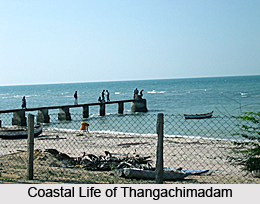 Thangachimadam is a hamlet in the central part of Rameswaram. This island is referred as the holy island in the state of Tamil Nadu.
Thangachimadam is a hamlet in the central part of Rameswaram. This island is referred as the holy island in the state of Tamil Nadu.
Thangachimadam is separated from the mainland by Pamban Island channel. The languages spoken in this village include Tamil language and English language. Thangachimadam enjoys the hot tropical climate temperature ranging from 25 degree Celsius to 46 degree Celsius. The relative humidity in this region is high at 79 percent on an average and it ranges between 80 percent to 90 percent. The winter season ranges from 30 degree Celsius and 25 degree Celsius, and the average rainfall is in 500 millimetres.
The main occupation of people of Thangachimadam is fishing and its associated occupations. This temple village is famed for its Jasmine "Maduai Malli". But the seedlings are grown for Thangachimadam and transported across South.
Jasmine is almost synonymous with the temple city of Madurai but the famed Madurai malli has its origin in the little known village of Thangachimadam, which is located on Rameswaram Island or Pamban Island.
The jasmine nurseries abound in this coastal village is the secondary occupation in this region. Around 300 farmers cultivate the exotic jasmine variety that is known for its unique fragrance. The small nurseries cover at least 150 acres in the village. This agro based industry is famed in the national and international market.
Thangachimadam village includes temples like Balathandayuthapani Swamy Temple, Sri Ekantharamar Swamy temple, Villoondi Thirtham, Ekantha Ramar Temple,
Vivekanandar Manimandapam and many other temples. This village also include St. James church, St. Theresa Church, Kattu Velanganni Church, Santhiyagappar Church, St. Infant Jesus Church and St Xavier"s Church. A Muslim Mosque is also there attracts lot of pilgrims through out the year.



















